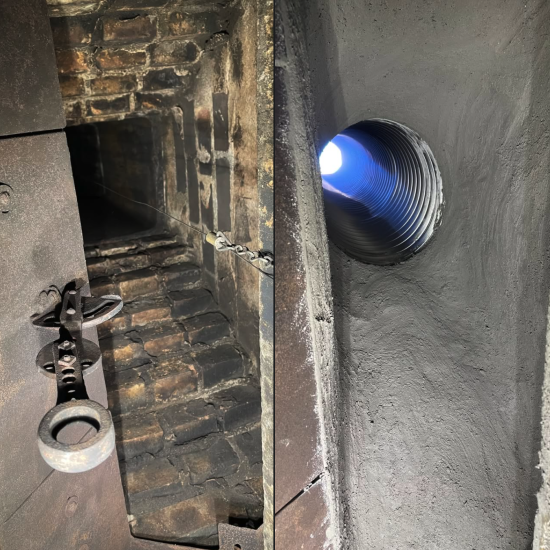Why Chimney Liners Matter: Safety, Efficiency, and Peace of Mind

When you think about maintaining your fireplace, you may focus on cleaning the chimney or checking for cracks in the brickwork. However, the chimney lining system is one critical part of chimney maintenance that often gets overlooked. Chimney relining when the flue system is damaged or deteriorating is essential for safety and efficiency. Helping your fireplace to perform optimally while minimizing risk to your home.
Let’s dive into why chimney relining is necessary, how it works, and when it’s time to consider a relining project.
What Is Chimney Relining?
Chimney relining refers to the process of replacing or repairing the liner inside your chimney. Chimney liners serve as a protective barrier between the gases and heat produced by your fire and the combustible materials surrounding your chimney, such as wood framing or insulation. Carrying byproducts of combustion up and out of the home. Over time, the liner can deteriorate or sustain damage, potentially posing a safety hazard.
Why Is Chimney Relining Important?
There are several key reasons why chimney relining is crucial for homeowners:
-
Fire Safety: The primary purpose of a chimney liner is to contain the high heat and combustion gases produced by your fireplace or stove. A damaged or deteriorated liner increases the risk of damage to the home. Embers and heat can escape through cracks or gaps in the lining, potentially igniting nearby combustible materials. Relining the fireplace chimney along with proper insulation helps to contain heat and debris while ensuring the system runs as safely and efficiently as possible.
-
Carbon Monoxide Protection: If your chimney liner is cracked, missing mortar joints, or non-existent, toxic gases such as carbon monoxide could leak into your home. Carbon monoxide is odorless, colorless, and potentially fatal. A new, properly installed liner keeps these harmful gases contained and assists the gasses and byproducts of combustion to move up and out of the home.
-
Preventing Structural Damage: Over time, the heat and gasses from your fireplace can cause wear and tear to your chimney’s masonry and structure. If the chimney liner is deteriorating or damaged, it can accelerate this damage, leading to more expensive repairs. Relining the chimney restores the integrity of your chimney flue and helps prevent the fireplace flue from contributing to exterior masonry deterioration.
Over time, your chimney liner can wear out or become damaged. Here are a few signs that it may be time to have your chimney relined:
- Cracked or Crumbling Masonry: If you notice cracks in your chimney’s masonry or if pieces of mortar are falling out, this could be a sign that your fireplace or gas appliance liner is damaged, deteriorating, or non-existent.
- Poor Ventilation: If your fireplace isn’t venting properly, producing excess smoke, or causing backdrafts, it may be due to a compromised chimney flue and/or liner.
- Rust or Corrosion: Rust or corrosion inside the fireplace, damper, flue, or chimney lining indicates moisture damage, which can be caused by a failing liner.
- Frequent Soot Buildup: Excessive soot buildup could be a sign that your chimney isn’t venting efficiently, which might be due to a flue liner problem.
- Chimney Fire: If you are aware or believe that you may have experienced a high heat event, more commonly known as a "Chimney Fire," it is crucial that you have your fireplace and chimney inspected for potential damage to the flue system. Often, the drastic change in temperature, as experienced in a high-heat event, will cause the interior tile or liner to be damaged.
Even if there are no outwardly signs your liner may be failing it is important to maintain annual safety inspections by a CSIA Certified Technician to ensure there are no visible defects to your fireplace, interior flue liner, and chimney. Inspections should be performed annually even after any necessary repairs are made.
The Chimney Relining Process
Chimney relining is a job best left to certified professionals, as it requires skill, education, and experience to ensure the job is done correctly. The process typically involves the following steps:
-
Inspection: A chimney sweep will inspect the existing liner to determine if it needs replacing or if it can be repaired. This might involve using cameras to examine the interior of the chimney.
-
Removal (if necessary): If the old liner is severely damaged, deteriorated, or unable to accommodate a properly sized replacement liner, it will need to be removed. This may involve breaking out flue tiles, cleaning out the chimney flue, and removing any debris or old materials.
-
Relining: The new liner is installed from the top of the smoke chamber or the top of the stove, insert, or prefabricated fireplace. Lining material will be chosen based on the fireplace or unit that the liner is venting and the manufacturer's requirements. When necessary or required, the flue liner will be insulated with either poured chimney insulation, pre-insulated liner or a wrap chimney insulation. The connections will be secured and/or the smoke chamber will be parged smooth creating a seamless transition from the fireplace to the liner that is installed. A termination cover or Energy Top Damper is then installed at the top of the chimney.
Conclusion
Ensuring that your chimney flue is free of defects is an essential part of maintaining your fireplace’s safety, efficiency, and functionality. If your chimney liner is damaged, worn out, or missing, it’s important to address the issue before it leads to safety hazards or further costly damage. By investing in and maintaining your chimney liner, you will be able to ensure you are keeping your fireplace up to standards for use and preventing to the best of your ability any damage to your home.
If you’re unsure whether your chimney needs relining or if you’d like a professional inspection, don’t hesitate to reach out. Our team of certified chimney sweeps is here to help keep your home safe and your fireplace in top condition.

